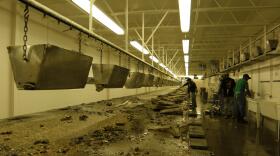In 2009, President Obama signed an executive order recognizing the Chesapeake Bay as a national treasure. That began a federal-state partnership to restore and protect it, including a plan to revive the wild oyster population through sanctuaries on restored reefs in Maryland and Virginia.
But President Trump's proposed budget eliminates funding for that plan, further complicating an already complicated effort to restore the reefs gutted by a century of overfishing, disease and pollution.
Pamela D'Angelo reports for Chesapeake: A Journalism Collaborative.
The initial plan called for restoring reefs in 20 tributaries by 2025. But that was scaled back to 10 tributaries. And then, restoration efforts were slowed by the lack of shell baby oysters need to latch onto.
Louis Snead, who manages the project for the U.S. Army Corps of Engineers Baltimore District, said a contractor told them last month they had run out of shell for a project in the Tred Avon River on the Eastern Shore.
"We don't know why there wasn't enough shell," he said. "We've gotten as much as we can get for now until they have a chance to accumulate more."
Oysters are a vital part of the bay’s economy and they are filter feeders that help clean the bay.
The Tred Avon project is just south of the bay's largest restoration project – Harris Creek, which covers 350 acres.
The Harris Creek project was completed two years ago using granite, shells and other materials for the substrate for baby oysters.
But watermen and boaters objected to using stone in the Tred Avon and that delayed the project so long that $1 million in federal funds was transferred to Virginia.
Some of that money is in use on the Piankatank River. The Corps of Engineers’ Norfolk District office has partnered with the Nature Conservancy and the Virginia Marine Resources Commission to build a 25-acre sanctuary reef in the tiny Bay tributary east of Richmond. And for the first time, Virginia, which also has a shell shortage, is using large granite blocks instead of shell.
Andrew Button, who heads Virginia's oyster replenishment program says you can put just about any kind of substrate on the bottom at the right time of the year, "and this is the perfect time of year to do this project."
By this time next year, he said, "all this granite should be covered in living oysters."
Susan Conner, who heads planning and policy for the Norfolk District, says the projects are looking good.
"Both Baltimore District and Norfolk District and our state partners have monitored the oyster reefs that we've been building for about ten years," she said. "And they're really showing healthy oyster populations."
But the biggest hurdle the two states face is President Trump’s budgetary knife. It has sliced federal funding for sanctuaries in four more tributaries and for in-depth scientific monitoring that begins when the oysters reach their prime at three years old. The Nature Conservancy has asked Congress to restore federal funding to 2012-2015 levels of $5 million.
The organization’s Andy Lacatell says they "still have a pretty long way to go" in the Piankatank "to get to at least a minimally restored functional oyster network."
"It's going to take significant funding," he said. "It's going to take support from our state General Assembly, it's going to take support from our Congressional representatives to continue to fund oyster restoration in the bay."
For now, at least, the shortage for finishing the Tred Avon and the other projects isn't about money. It’s about shell. At least until September when Congress finishes work on the federal budget.
Chesapeake: A Journalism Collaborative is funded with grant support from the Clayton Baker Trust, The Bancroft Foundation, Michael and Ann Hankin, The Jim and Patty Rouse Foundation, The Rob and Elizabeth Tyler Foundation, and the Mid-Shore Community Foundation.






